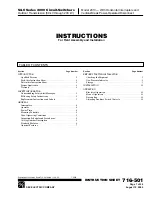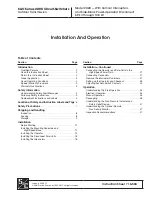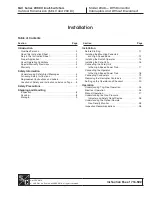
4 - 116 WiNG 4.4 Switch System Reference Guide
4.7.9 Smart RF
When invoked by an administrator, Smart RF (or self-monitoring at run time) instructs radios to change to a specific channel
and begin beaconing using their maximum available transmit power. Within a well planned deployment, any associated
radio should be reachable by at least one other radio. The Smart RF feature records signals received from its neighbors as
well as signals from external, un-managed radios. AP to AP distance is recorded in terms of signal attenuation. The
information from external radios is used during channel assignment to minimize interference.
Smart RF management is comprised of the following two phases:
•
Smart RF Calibration Phase
•
Smart RF Monitoring Phase
Smart RF is well suited for clustered environments. Smart RF interacts with a number of existing features, (such as radio
detection, MU load balancing, and self-healing).
4.7.9.1 Smart RF Calibration Phase
Smart RF calibration is initiated by an administrator during initial deployment or can be scheduled at a specified frequency
or time of the day. Smart RF instructs adopted radios to scan legal channels and measure signal strength from associated
radio and other device signals detected within the environment.
Smart RF conducts the following network management activities:
• Automatically calibrates associated radio's maximum power capability
• Automatically assigns certain radios to be detectors
• Automatically assign channels to radios to avoid channel overlap and interference from external RF sources
• Automatically calculates the transmit power of working radios
• Automatically configures self-healing parameters. Radio assume the roles of caretaker and caregiver. When a radio is
down, it is referred to as the caretaker. Neighbor radios raising their transmit power to cover for the failed radio are
referred to as caregivers. Smart RF calibration automatically chooses caregiver radios along with the power needed to
cover.
4.7.9.2 Smart RF Monitoring Phase
Smart RF monitoring occurs continuously. It includes the following monitoring activities:
• Self-healing to monitor whether a radio is down
• Interference monitoring using retry stats
• Defines coverage holes and discerns transmit rates and MU signal strength. When necessary, Smart RF increases MU
power to maintain coverage
• Extensible to future smart-tuning. For example, distinguish between AP to AP interference and static interference
4.7.9.3 Viewing Smart RF Information
To view Smart RF information:
1. Select
Network
>
Access Port Radios
from the main menu tree.
CAUTION:
SmartRF should only be enabled on AP300 & AP-5131 when using antennas
with gains of 7dBi or less. For AP-7131 it should only be used with the façade antenna,
and for AP650 it should only be used with internal antenna models.
!
Summary of Contents for WiNG 4.4
Page 1: ...Motorola Solutions WiNG 4 4 SYSTEM REFERENCE GUIDE ...
Page 2: ......
Page 3: ...MOTOROLA SOLUTIONS WING 4 4 SYSTEM REFERENCE GUIDE 72E 157062 01 Revision A January 2012 ...
Page 6: ...iv WiNG 4 4 Switch System Reference Guide ...
Page 14: ...xii WiNG 4 4 Switch System Reference Guide ...
Page 48: ...1 32 WiNG 4 4 Switch System Reference Guide ...
Page 58: ...2 10 WiNG 4 4 Switch System Reference Guide ...
Page 280: ...4 176 WiNG 4 4 Switch System Reference Guide ...
Page 352: ...5 72 WiNG 4 4 Switch System Reference Guide ...
Page 476: ...6 124 WiNG 4 4 Switch System Reference Guide ...
Page 506: ...7 30 WiNG 4 4 Switch System Reference Guide ...
Page 532: ...8 26 WiNG 4 4 Switch System Reference Guide ...
Page 536: ...A 4 WiNG 4 4 Switch System Reference Guide ...
Page 544: ...B 12 WiNG 4 4 Switch System Reference Guide ...
Page 558: ...B 26 WiNG 4 4 Switch System Reference Guide ...
Page 574: ...C 16 WiNG 4 4 Switch System Reference Guide ...
Page 596: ...E 4 WiNG 4 4 Switch System Reference Guide ...
Page 597: ......
















































